
Benvenuto Tisi, also known as Il Garofalo, was a Late-Renaissance-Mannerist Italian painter of the School of Ferrara. Garofalo's career began attached to the court of the Duke d'Este. His early works have been described as "idyllic", but they often conform to the elaborate conceits favored by the artistically refined Ferrarese court. His nickname, Garofalo, may derive from his habit of signing some works with a picture of a carnation.

The Galleria Nazionale d'Arte Antica or National Gallery of Ancient Art is an art museum in Rome, Italy. It is the principal national collection of older paintings in Rome – mostly from before 1800; it does not hold any antiquities. It has two sites: the Palazzo Barberini and the Palazzo Corsini.

Adoration of the Shepherds is the title of a lost drawing by Raphael, described in a letter of 8 September 1508, from Raphael to his friend Francesco Raibolini alias Francesco Francia. This letter's contents were first published in 1678, in Carlo Cesare Malvasia's book Felsina Pittrice. Malvasia gave a full account of the letter, which he claimed to have found among the papers of Count Antonio Lambertini in Bologna. While the existence and contents of the letter are disputed, according to Malvasia it described the delivery of a drawing of the Adoration of the Shepherds to Francesco Francia. This drawing has been considered lost or never to have existed.

Holy Family with a Shepherd is an oil on canvas painting by Titian, from c. 1510. It is held in the National Gallery, in London. It has also previously been attributed to Anthony van Dyck, who produced a drawing copying it. After passing through other private collections, it was bequeathed to the National Gallery by William Holwell Carr in 1831.

Cain and Abel is an oil painting by the Venetian painter Titian. It was made in about 1543–1545 for the church of Santo Spirito, but is now in the basilica of Santa Maria della Salute.

Abraham and Isaac, also known as the Sacrifice of Isaac, is an oil painting by the Venetian painter Titian. It was made in about 1543–1544 for the church of Santo Spirito, but is now in the basilica of Santa Maria della Salute.

Salome, also known as Salome with the Head of John the Baptist, is an oil painting by the Venetian painter Titian, made in about 1550, and currently in the collection of the Museo del Prado in Madrid. It is not to be confused with other compositions of Salome and Judith by Titian.

Portrait of Jacopo Sannazaro, also known as Portrait of a Man, is an oil painting by the Venetian master Titian, dated to about 1513. It is part of the Royal Collection, and hangs in Buckingham Palace.

Nymph and Shepherd, also called Shepherd and Nymph, is an oil painting by the Venetian master Titian, made about 1570. The painting is in the collection of the Kunsthistorisches Museum, in Vienna.
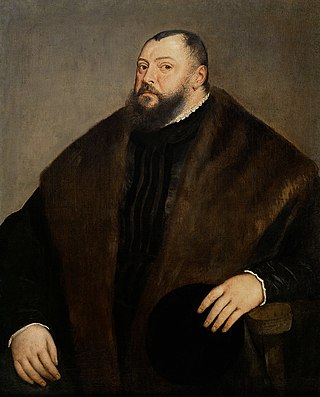
Portrait of John Frederick I, Elector of Saxony is an oil on canvas painting by the Venetian painter Titian, made in late 1550 or early 1551. The painting is in the collection of the Kunsthistorisches Museum, in Vienna.
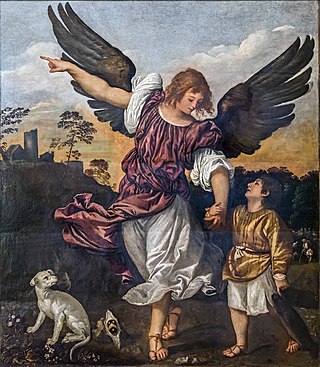
The Archangel Raphael and Tobias is an oil painting by Titian of Tobias and the Angel, dated to about 1512 to 1514, which is now in the Gallerie dell'Accademia in Venice. Another painting by Titian of the same subject, entitled Tobias and the Angel, dated to about 1540 to 1545, remains in the church of the Madonna dell'Orto in Venice.
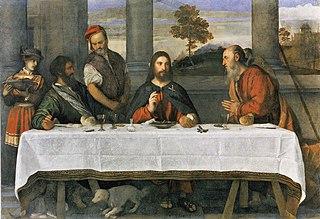
The Supper at Emmaus is the title shared by several similar works by Titian, two of which are discussed here. The first, made about 1534, is currently on long-term loan to the Walker Art Gallery in Liverpool. The second, made about 1545 by Titian and his studio, is in the National Gallery of Ireland in Dublin.

The Ecce Homo is a large oil painting by Titian, signed and dated 1543, which hangs in the Kunsthistorisches Museum in Vienna. It is not to be confused with several smaller compositions by Titian.
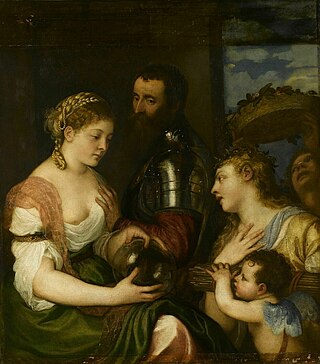
The Allegory of Marriage, also titled the Allegory of Separation, and formerly known as the Allegory of Alfonso d'Avalos, is an oil painting by Titian, made about 1530 to 1535, in the collection of the Louvre. There are several fairly early copies, done after Titian, including two in the Royal Collection.

Portrait of a Man with a Falcon, also called Portrait of a Man of the Cornaro Family with a Falcon or Giorgio Cornaro with a Falcon, is an oil on canvas painting by the Italian painter Titian. It is variously dated from the late 1520s to the 1540s. The painting is in the collection of the Joslyn Art Museum in Omaha.
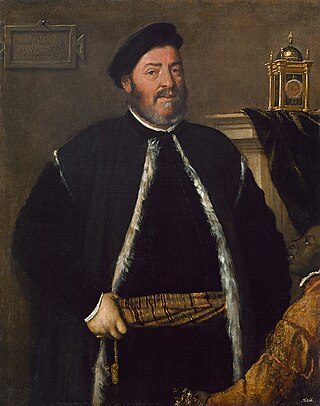
Portrait of Fabrizio Salvaresio is an oil painting by Titian. It is signed and dated 1558, and hangs today in the Kunsthistorisches Museum, in Vienna.
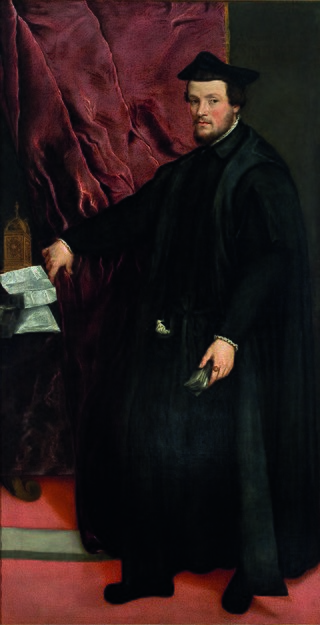
Portrait of Cardinal Cristoforo Madruzzo is an oil painting by Titian, signed and dated of 1552, which hangs in the São Paulo Museum of Art.

The Virgin and Child with Saints Stephen, Jerome and Maurice, also called the Virgin with Three Saints, is a religious painting by Titian, from c. 1510-1525. It hangs in the Louvre, in Paris.

The Virgin and Child with Saint John the Baptist and an Unidentified Saint, also called the Virgin with Saint John the Baptist, adored by a Donor, is a religious painting by Titian, dated to between 1515 and 1520, which is currently on loan to the Scottish National Gallery.

Portrait of Count Antonio Porcia and Brugnera is an oil painting by Titian, dated to c. 1535-1540. It hangs in the Pinacoteca di Brera, in Milan.


























